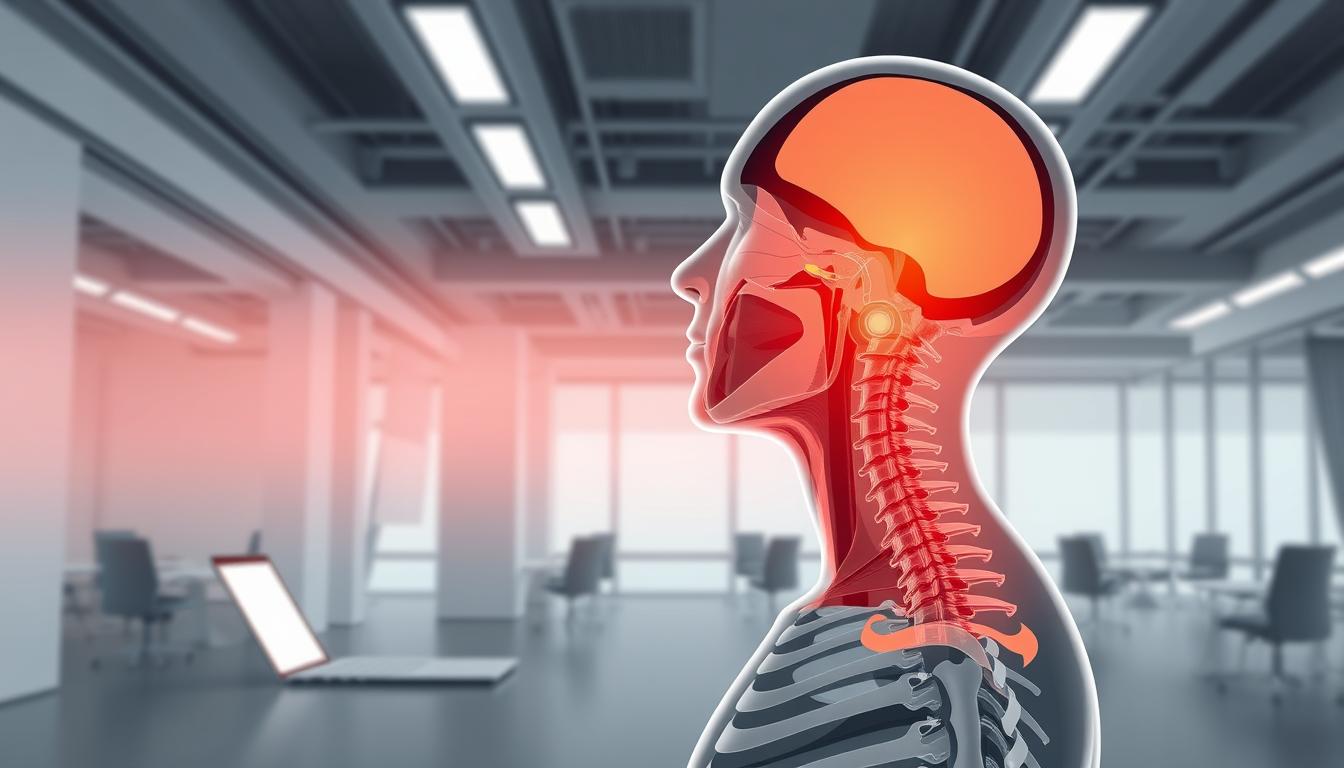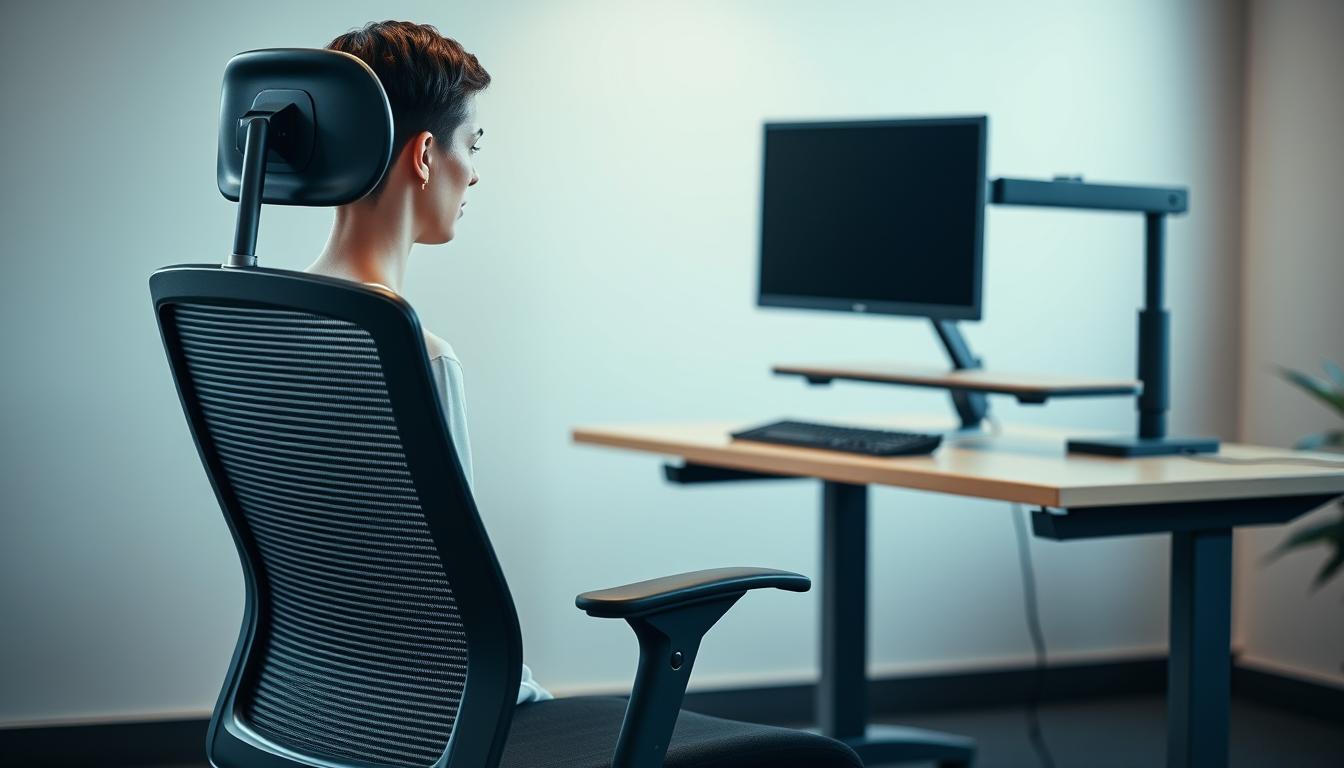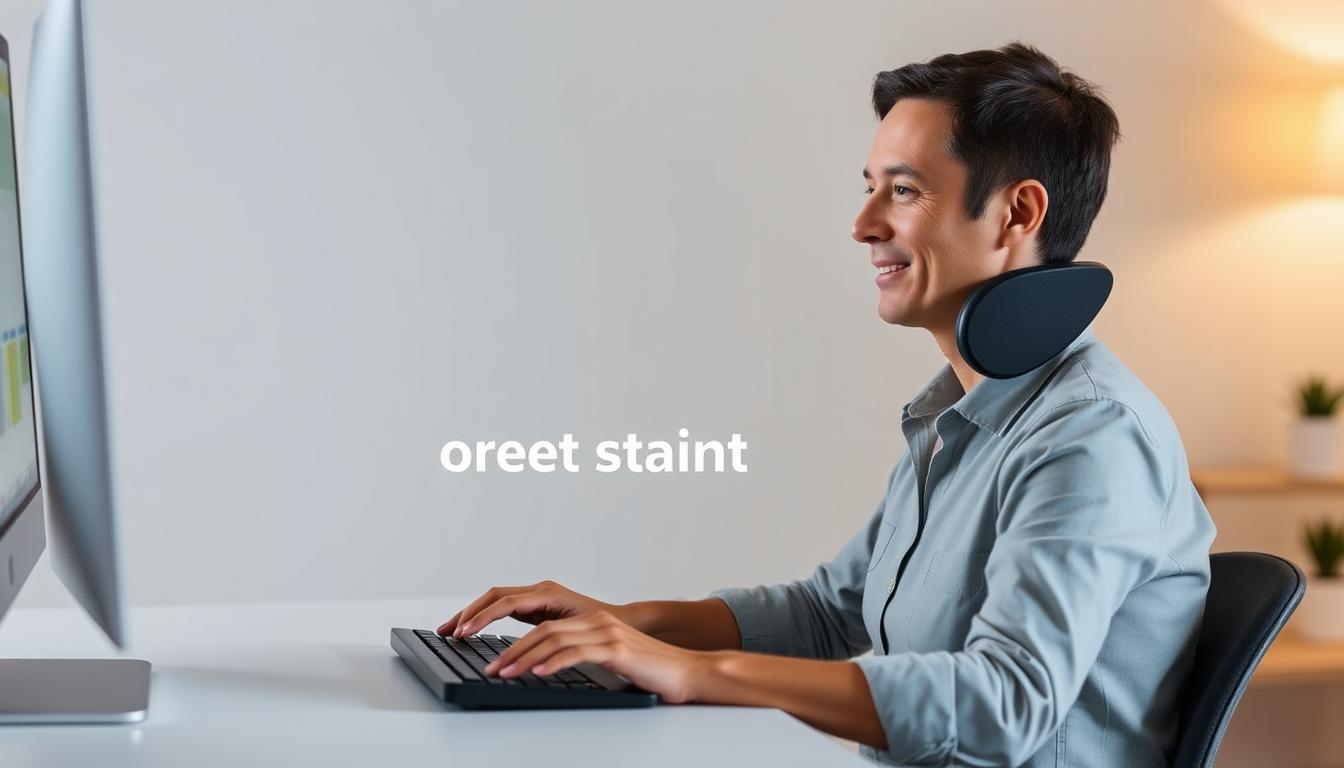In today’s fast world, having a neck-friendly workstation is key.This ergonomic guide shows how good work setups prevent neck and back pain. It helps you stay healthy and work better. Learning about the right tools and setup can stop common problems like neck strain and injuries from repeating movements. Follow expert advice to make your work area comfortable and supportive. This will lead to more tips on setting up your space right.
Understanding the Importance of Ergonomics
Ergonomics is key to keeping you healthy and comfy at work. It’s all about making your workspace fit you perfectly. This can boost your mood and how well you do your job. If your desk set up isn’t right, you might end up with constant aches. This can mess with your work and health. But, if we use ergonomics right, we can fix these problems. It helps you sit better and puts less strain on your body.
Studies highlight how crucial ergonomics is in all types of offices. Making the right tweaks can help your blood flow better. It can make you feel less sore and think more clearly. People who have an ergonomic workspace tend to do their tasks better. They also feel happier. Ignoring ergonomics can lead to serious health issues. This includes problems with your muscles and bones, and even feeling worn out.
Choosing the Right Ergonomic Chair
Finding the right ergonomic chair is key to a healthy work area. It should keep your body properly aligned and comfortable, especially during long hours of sitting. Look for a chair that lets you change its height and has lumbar support. These features are vital for a good sitting posture.
Adjusting Chair Height for Optimal Comfort
It’s important to adjust your chair’s height for the best comfort. A well-adjusted chair supports your feet resting flat on the ground and your knees at a right angle. This position lessens the strain on your back and legs. Here’s how to adjust your chair properly:
- Set the chair height so your thighs stay parallel to the floor.
- Keep your feet flat on the ground, or use a footrest if needed.
- Your elbows to your wrists should be in a straight line when you type.
Lumbar Support and Posture
Lumbar support is crucial for a good posture and avoiding lower back pain. Your ergonomic chair should have a backrest that matches your spine’s curve. The right lumbar support keeps your spine neutral, making you feel less tired when sitting for a long time. To get the most out of lumbar support:
- Adjust your backrest to fit against your lower back snugly.
- Make sure your shoulders are relaxed and your back feels supported.
- Look for chairs where you can change the lumbar support to fit your needs.
Desk Setup for a Neck-Friendly Workstation
A well-set desk is key to a neck-friendly workstation. Having the right desk setup helps you stay comfortable all day. It’s important to adjust your desk’s height so it fits with your chair. This lets your elbows rest easily while typing. Also, make sure you have enough space for your legs under the desk. Avoid storing stuff under there as it can limit movement and cause strain.
Optimal Desk Height and Space Requirements
The height of your desk should match your chair’s height. If your desk is too high or too low, it can make you uncomfortable and hurt your posture. If you can’t adjust your desk, using sturdy blocks can help reach the right height. The right height lets you keep an arm’s length from the monitor and have enough space for your legs under the desk.
Positioning of Frequently Used Items
Organizing your workspace well is important for staying productive. Make sure things you use a lot, like your phone and documents, are easy to reach. This helps prevent unnecessary stretching that could hurt your neck and shoulders. A tidy desk helps you work smoothly and quickly access what you need without awkward movements that can mess up your desk’s ergonomics.
How to Set Up a Neck-Friendly Workstation
Creating a neck-friendly workstation is key to staying comfortable during long computer use hours. The right monitor position is crucial. It lessens neck strain and makes your work area comfy. Follow monitor placement guidelines to keep a good posture and fight off tiredness.
Monitor Positioning Guidelines
For the best monitor height, put the screen right in front of you. Its top edge should be at or a bit below eye level. This setup lets your eyes look down gently, reducing the need to move your neck. If your monitor is too high or too low, you could strain your neck, causing discomfort over time.
Maintaining an Appropriate Distance from the Screen
Keeping the right distance from your screen is also key for a comfy workstation. Your monitor should be about 20-40 inches from your eyes. This spacing cuts down on eye strain and neck pain from bad viewing angles. Following this rule makes focusing easier and lessens tiredness during work.
Keyboard and Mouse Alignment
Getting your keyboard and mouse lined up right is key for a comfy work area. It helps a lot for feeling good and working well, and stops you from getting hurt. Knowing the best way to align your gear makes sure your hands and wrists stay happy.
Achieving Elbow Height for Keyboard Use
For your keyboard, keeping your elbows right is a must. They should make a 90-degree angle, with your arms flat like the table. This keeps your wrists straight and chill while you’re typing. Here’s how to get your setup just right:
- Adjust your chair so your elbows hang easy by your side.
- Look for keyboards that let you change the angle and height.
- Think about using gear that helps keep your wrists natural when you type.
Positioning the Mouse for Ease of Use
Where your mouse sits is just as important for a good setup. Put it right next to your keyboard to avoid stretching. This makes moving between typing and using your mouse smooth. Keep these tips in mind to make things even better:
- Make sure your mouse and keyboard are at the same level.
- Keep the mouse close so your hand stays comfy.
- Try out different supports, like a mouse pad with wrist help, to see what’s best.
Lighting Considerations for Your Work Area
Right lighting is key in making your workspace comfy and productive. It’s important to cut down on glare and use ergonomic lighting for a better work experience. This part talks about ways to make sure your area is lit well, making it both comfy and efficient.
Best Practices for Reducing Glare
Keeping glare low is vital for eye comfort and less strain. Here are methods to lessen glare:
- Position your monitor away from windows to limit exposure to harsh daylight.
- Utilize blinds or curtains to control the amount of natural light entering the workspace.
- Adjust overhead lighting to avoid direct reflection on the screen surface.
- Choose matte screen filters to soften reflections and enhance visibility.
Using Adjustable Task Lighting
Add adjustable task lighting to your area for custom lighting needs. This ergonomic lighting helps you:
- Direct the light exactly where it’s needed for focused tasks.
- Modify brightness levels based on activity, from reading documents to detailed design work.
- Avoid straining the neck by positioning lamps to shine directly on work surfaces without leaning forward.
Incorporating a Sit-Stand Desk
The modern workplace is always changing. Ergonomic desks that improve health have become very important. A great choice is a sit-stand desk. It lets users change their height while working, encouraging more movement. These desks make a big difference in comfort and productivity.
Benefits of Alternating Between Sitting and Standing
Switching between sitting and standing can really help reduce neck and back pain. Research has proven this practice offers big benefits:
- Improved posture and spinal alignment
- Increased energy and focus
- Reduction in musculoskeletal issues
- Enhanced mood and productivity levels
These benefits create a healthier workplace. It shows why ergonomic desks are so important for supporting various work positions.
Adjustments for Standing Desk Use
Making the right adjustments is key to enjoying your sit-stand desk. For the best comfort while standing, try these tips:
- Set the desk height so that elbows remain at a 90-degree angle.
- Keep the monitor at eye level to avoid neck strain.
- Ensure that feet are flat on the ground or on a footrest to promote stability.
Keeping the right stance while standing is crucial. It helps reduce discomfort. And it lets users enjoy the benefits of switching between sitting and standing.
Maintaining Proper Neck and Shoulder Positioning
Getting your neck and shoulder position right is key to stopping neck strain. It also helps keep your shoulders healthy. Having your workstation set up ergonomically ensures you’re comfy all day. It boosts your work and well-being. Make sure your monitor is at the right height for the best ergonomic setup.
Reducing Neck Strain with Proper Monitor Height
It’s important to place your monitor correctly to avoid neck pain. The top of your monitor should be at your eye level. This helps keep your neck straight when you’re working. If your head tilts too much, it can hurt over time. A monitor that’s too high or low will make your neck and shoulders ache and mess up your posture.
Common Mistakes to Avoid
To stop discomfort, know what mistakes to avoid with your workstation. Some common errors include:
- Having your monitor too low so you have to look down a lot.
- Choosing a chair that doesn’t support your lower back and shoulders right.
- Not sitting straight, which may cause pain after a while.
- Keeping things you use often too far away, leading to awkward movements and strain.

Utilizing Ergonomic Tools and Accessories
Making your workstation comfortable and efficient is more than just moving your chair and desk around. Adding ergonomic tools and accessories really helps increase both comfort and how much you get done. Items like keyboard pads and monitor stands help place everything just right. They also cut down on soreness during long hours of work.
Keyboard and Mouse Pads for Support
Keyboard pads are key for ergonomic setups because they give your wrists the support they need while you type. This helps to ease pain and avoid injuries from doing the same movements over and over. Using a mouse pad with wrist support adds to the ease and control, smoothing out each click and movement. Main perks are:
- Improving how your wrist lines up to lessen strain.
- Making long periods of use more comfortable.
- Boosting how much you can do by keeping focus sharp.
Monitor Stands for Eye Level Positioning
Setting your monitor at the right height is vital for keeping your neck healthy. Using monitor stands to raise your screen to eye level helps you keep your spine straight. This makes neck pain less likely and supports good posture all day. When shopping for monitor stands, look for:
- A sturdy base to avoid wobbles or falls.
- The ability to adjust it to the height you need.
- Being able to fit monitors of various sizes.
The Role of Regular Breaks in Ergonomics
Breaks are very important in any ergonomic work setup. Taking regular time off from work boosts productivity. It also encourages you to move around, which is good for health.
Sitting too long can make your neck and shoulders hurt. So, it’s very important to take many breaks every day.
Importance of Movement for Neck Health
Moving around is key to keeping your neck healthy. Getting up to stretch often helps blood flow and lowers the chance of pain. Try to take brief breaks every 30 to 60 minutes.
This habit eases tension and increases focus. It also makes working more comfortable.
Doing simple stretches can help your neck feel better. Try these exercises when you take a break:
- Neck tilts: Gently tilt your head towards each shoulder, holding for a few seconds.
- Chin tucks: Pull your chin back towards your neck to stretch the muscles.
- Shoulder rolls: Rotate your shoulders backward and forward to release tension.
These stretches are easy and quick. They can make your workday more productive and your body feel great.
Creating a Personalized Workspace
Creating a workspace that feels yours is key for feeling good and working well. Everyone has their own likes and special needs. This is why making your workspace fit you is so crucial. Adding your flair and making sure things work for you makes your space much better. Keep checking and tweaking how your setup works for you. This can help you feel better every day.
Assessing and Tweaking Your Setup for Comfort
To make your workspace just right, think about these things:
- Workspace Arrangement: Make sure your desk layout is easy to move around, everything you need is within reach, and it’s not too cluttered.
- Equipment Selection: Pick tools that are comfy for you, like a chair and keyboard that you can adjust to fit perfectly.
- Adaptability: Be ready to change things up. Little tweaks, like moving your chair up or the screen tilt, can make a big difference in how comfortable you are.
When you focus on making your workspace fit you, you’ll work better and feel nicer doing it.
Common Ergonomic Mistakes to Avoid
Knowing common ergonomic mistakes in your workspace is key for comfort and getting more done. Being aware of poor ergonomics signs can make your work spot better. Issues like ongoing neck pain, back trouble, and feeling tired at work show something is wrong.
Signs of Poor Ergonomic Setup
- Chronic neck or shoulder pain after sitting at your desk for a long time.
- Problems reaching your keyboard or mouse, which means they’re not placed right.
- Regular headaches caused by eye strain from a monitor that’s too high or low.
- Feet not reaching the ground or thigh pressure when sitting.
Tips for Quick Fixes to Improve Comfort
- Make sure your chair is high enough so your feet can be flat on the floor and knees at a right angle.
- Move your monitor to eye level to stop neck strain and help you sit up straight.
- Use ergonomic items like good chairs and desks you can adjust for better body alignment.
- Take breaks to stand up, stretch, and walk around to boost productivity and prevent stiffness.
Conclusion
Making your workstation neck-friendly is key for better health at work. We’ve looked at how to set up your space right, from picking a good chair to where your monitor sits. These steps help make work comfortable and help you do better in your job.
Small changes can make a big difference in your work area. You might adjust your chair or desk, use helpful tools, or take breaks often. Each action helps keep your neck and back happy, which is good for you now and later.
Start using these tips and talk to your boss about making your workspace even better. Or make changes to your setup at home. By staying focused and making these tweaks, you’ll see great improvements in how you feel working every day.



